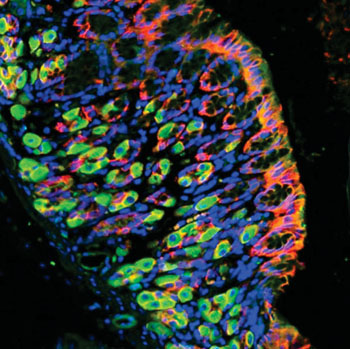Genomic Aberrations of Asian Gastric Cancer Discovered
By LabMedica International staff writers
Posted on 20 Jul 2015
The fusion of two genes gives rise to the destruction of the stomach surface barrier, resulting in gastric acids affecting the stomach tissues; moreover, this fusion also hampers wound-healing.Posted on 20 Jul 2015
Structural changes of chromosomes or genome rearrangements can result in gene fusions with properties that can cause cancer and the three-dimensional organization of the genome, known as the chromatin structure, plays a role for the generation of rearrangements.

Image: Immunofluorescence image of human stomach section stained for ARHGAP26 (green), epithelial cadherin (red), and cell nuclei (blue). Epithelial cadherin is present in all epithelial cell types of the stomach, whereas ARHGAP26 is restricted to parietal cells (Photo courtesy of A*STAR\'s Genome Institute of Singapore).
Scientists at The Agency for Science, Technology and Research (A*STAR, Singapore) and their colleagues used a technique known as DNA paired-end-tag (DNA-PET) whole genome sequencing, to analyze15 gastric cancers (GCs) from Southeast Asians, and observed that rearrangements were enriched in regions of active genes. They subsequently screened 100 GCs for certain fusion genes that were discovered in the 15 GCs.
Through the sequencing, the scientists identified seven hotspots across the genome which had many rearrangements as well as 136 gene fusions. In three out of the 100 GC cases, they found recurrent fusions between Claudin 18 (CLDN18), a tight junction gene, and Rho GTPase Activating Protein 26 (ARHGAP26), a gene encoding a Ras homolog gene family, member A (RHOA) inhibitor. The functions of both genes are important for a tight inner surface (epithelium) of the stomach. Epithelial cell lines expressing the fused genes CLDN18-ARHGAP26 displayed a dramatic loss of epithelial phenotype and long protrusions indicative of epithelial-mesenchymal transition (EMT). Overall, CLDN18-ARHGAP26 mediates epithelial disintegration possibly leading to leakage of gastric acids, and the fusion might contribute to invasiveness of tumors once a cell is transformed.
Walter Hunziker, PhD, a senior coauthor of the study said, “CLDN18 is a critical component of the gastric epithelial barrier. Fusion of ARHGAP26 to CLDN18 not only interferes with the tethering of CLDN18 to the actin cytoskeleton, but could also affect the actin cytoskeleton by inhibiting RHOA at the wrong location, thereby compromising barrier integrity. The resulting inflammation and gastritis are well known risk factors for gastric cancer.” The study was published on July 2, 2015, in the journal Cell Reports.
Related Links:
The Agency for Science, Technology and Research













